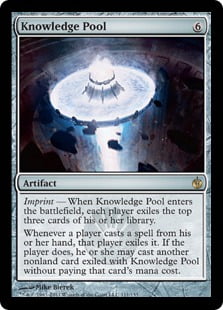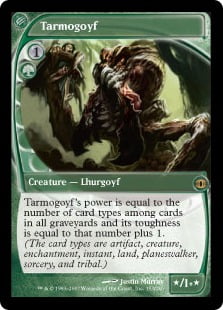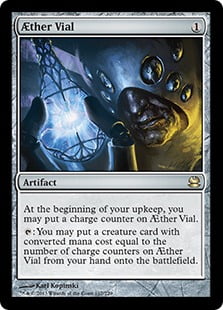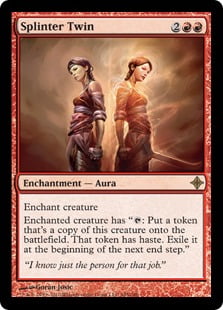Posts Tagged ‘gp boston’
GP Boston-Worcester Top 32 Deck List: U/B Teachings by Carl Godon
Monday, July 28th, 2014

In case you missed it, GP Boston-Worcester came and went this past weekend. Several of our local players went on to make Day 2 of the event, including Nick Blake and myself. Carl is a local player who frequents the Abington store. He’s well know for his “unique and interesting” deck lists. So, it’s no surprise that people are wanting to know what he played this past weekend to a Top 32 finish at GP Boston-Worcester. It even peaked some interests when his deck got tweeted about. Here’s the list:
Creature:
3x Snapcaster Mage
2x Teferi, Mage of Zhalfir
1x Treasure Mage
1x Wurmcoil Engine
Sorcery:
3x Thoughtseize
2x Inquisition of Kozilek
1x Damnation
Instant:
1x Repeal
1x Smother
2x Disfigure
1x Hero’s Downfall
1x Darkblast
1x Mystical Teachings
2x Mana Leak
1x Consume the Meek
1x Slaughter Pact
1x Syncopate
2x Far//Away
3x Cryptic Command
2x Spell Snare
2x Think Twice
Artifact:
1x Knowledge Pool
Land:
1x Misty Rainforest
2x Scalding Tarn
3x Tectonic Edge
2x Dreadship Reef
2x Snow-Covered Swamp
4x Snow-Covered Island
4x Watery Grave
4x Creeping Tar Pit
2x Dark Slick Shores
1x Urborg, Tomb of Yawgmoth
Sideboard:
1x Devour Flesh
3x Pack Rat
1x Duress
1x Tectonic Edge
1x Thoughtseize
1x Mindbreak Trap
1x Grafdigger’s Cage
2x Shadow of Doubt
2x Threads of Disloyalty
1x Damping Matrix
1x Ashiok, Nightmare Weaver
That’s a lot of one-ofs and two-ofs, but it definitely looks like a “Carl” deck as we like to say. The most interesting part of the deck is Knowledge Pool, and, yes, you’re reading the deck list correctly. There is only one copy in the deck. Some of you who follow Jackie Lee on Twitter may have seen her post about how her “opponent casually” locked her out of the game with Knowledge Pool.
Opponent casually comboed me out with Teferi/Knowledge Pool. No big. 11-4 #GPBoston
— Jackie Lee (@JackieL33) July 27, 2014
The obvious question people had was, “What’s Knowledge Pool?” The next question was how Carl locked people out of the game with the card. The short version of the card is this: when the card is played, both players must exile the top three cards of their library. This is through the card’s “Imprint” mechanic. The card goes on to say that, now, whenever a player plays a spell, that spell is exiled. If the player exiles the card, they can cast any card that was originally exiled by Knowledge Pool and play it without paying it’s casting cost.
Sounds great, right? Well not if Teferi is in play. Confused? It’s okay. We all are. The lock is so obscure, I even had trouble forming words to explain it. Here is the best explanation thanks to the internet. “Knowledge Pool’s triggered ability is on the stack at the time they could cast an exiled spell from it, as the stack is not empty, that player could not cast a sorcery at this time. Thus they cannot cast any spells at this time due to Teferi’s effect, meaning knowledge pool exiles any spell not cast from hand without any return for opponents. So they only spells they cast not from hand (flashback for instance or via madness) can resolve and also land drops are unaffected.”
The strategy actually originates from EDH. This was one of the most interesting facts I found out while researching about the lock.
Well that’s it for now. I’ll be writing about my own experiences from this past weekend’s events, and, if you’re lucky, maybe we’ll even get Nick to talk about his time at the event as well.


Tags: carl godon, gp boston, Magic the Gathering, MTG, teachings, Wizards of the Coast, worcester
Posted in Blog, Card Games, Events, Featured Post, Magic: The Gathering, Popular Posts, Store Related | No Comments »
This week in Magic: A Modern Primer
Thursday, July 24th, 2014

Is it still Grand Prix Boston or is it Grand Prix Worcester? Even worse, do we call it Grand Prix Boston/Worcester? Actually, according to the official site of “Magic: The Gathering,” they have it listed as Grand Prix Boston-Worcester. Well, however you see it, the Grand Prix is finally here. Are you ready for it?
I’m as ready as I have ever been for a tournament. Never have I ever prepared this much for any kind of tournament. I have the attention span of bubble gum. For me to stick with a deck this long is unheard of. There is, of course, plenty of time for me to call an audible and switch decks the night before.
If all goes as planned, I will be running Mono Red Burn. This is slightly different from Red Deck Wins as this deck runs fewer creatures and a heavier burn package. This also should not come as a surprise as I have been writing about the deck for the past several weeks. Note: I do plan on finishing that series. I’ll most likely do it once the GP ends and will have final thoughts about it.
What about you? What are you planning on running? Don’t worry; there really is no wrong answer to that question. Here is a quick breakdown among the three different types of meta: Combo (37%), Control (27%), and Aggro (36%). Now that we know this info, let’s break things down even more. We’ll go a little more in-depth with each meta and look at the different decks that are the most popular within their meta.
Aggro
To no one’s surprise the top dog here is Affinity. This deck is so good and very fast. When you’re on the other side of things, there is no greater fear than watching your opponent drop their hand on the first turn of the game. Who knew that something like Signal Pest, such a small and very un-intimidating creature, can be so deadly? When he’s teamed up with his buddies Memnite and Ornithopter (even Inkmoth Nexus) things can quickly get out of hand. Knowing your opponent is playing Affinity is not always the end of all things. I’ve seen plenty of these decks sputter out and run out of gas. Keep your head cool and things will be okay.
Next up is Jund. This is one of those decks that took every powerful card in the format and smooshed them all together. Take a look at its creature package for example: 4x Tarmogoyf, 4x Dark Confidant, 3x Scavenging Ooze, and 3x Courser of Kruphix. A very strong creature package teamed with a very disruptive spell package, and you have the makings of the one of the best Aggro decks in the format. Thoughtseize, Inquisition, and Liliana are the best in the game. Get ready for a fight and have a well prepared backup plan ready when these are pointed at you.
I played against a UR Aggro deck at a recent GPT. I remember staring down a Young Pyromancer on turn two and had the choice of burning my opponent or killing the creature. It was early on in my Mono Red Burn experience, so I opted to burn my opponent in the face. I can definitely tell you that I paid for that mistake in full. The next time around, I did not hesitate to burn it and I went on to win the match. This deck is just a conglomerate of Delvers and a spell package tune for tempo. Don’t let this deck’s appearance fool you. It packs a solid punch.

Merfolk rounds out the top five decks in the Aggro meta. This deck takes full advantage of the Aether Vial and shows why this card is so powerful, no matter what format it’s in. You need to take these fish seriously. In it’s entire creature package, half of them are lords. Each one pumping the other up. Add Aether Vial into the mix and you have a recipe for destruction. One thing to keep in mind, though, is that while the Merfolk player is playing islands, they don’t play many counterspells. Don’t be afraid to run a spell or two out out there.
Control
I’ve always been a big fan of Tron decks. Therefore, to see this as top deck in the Control meta makes me very happy. Playing with the Urza Tron lands almost feels like cheating in a way, but you’re not. Being able to produce seven mana on turn three allows the player to do many silly things. One of those things is being able to cast Karn Liberated. At first glance, sure, he’s a pretty powerful planeswalker, but on turn three it’s not fair. After his first positive activation, he sits there at ten loyalty and almost impossible to kill with creatures. Even worse, he exiles permanents getting around any kind of indestructibility they might have. If you let things get too far, he just resets the game.
Tron decks have numerous ways to have fun besides Karn. If they need to they can play Wurmcoil Engines and even CAST Emrakul, the Aeons Torn.
In the recent weeks, I’ve seen GB Rock decks pick up in popularity. With their package of hand disruption, I’m not surprised, especially since Twin is one of the most popular decks in the format. I know what you’re saying, though. “Jund runs a similar package.” Yes, but now we’re dealing with two colors. In a format where mana can be a serious issue, having stability can be more appealing than added aggressiveness. Obstinate Baloth is a nice touch. Not only is it great against Mono Red decks, but it helps Rock players with sustainability, and Liliana is a real threat. Imagine discarding a Baloth to a Liliana? Ouch.
I’m going to put UW and UWx Midrange decks together. This color combination will always be a very popular choice. The strat is a little simple: control the game until late, then let your man-lands take over. It takes a special person to pilot control these kinds of decks. However, once mastered these decks can prove to be very powerful. With the splash of Red, the player gains access to spells like Lightning Bolt, Electrolyze, and an endless amount of ammo for your side board. The obvious difference between the decks is how aggressive the UWx Midrange decks can be. In the end, it really comes down to your play style.
Combo
This meta has some of the most powerful and popular decks in the format. However, while it may be difficult, they are not unbeatable. First up is Birthing Pod. This deck was a house in Standard. With an expanded line-up, there isn’t any surprise that it’s, once again, running the show. Although, from what I’ve heard, there hasn’t been much spotted in the Massachusetts area – at least in the South Shore. This is one of those tool box decks that plays numerous one-ofs. These “one-ofs” are enough to win a person the game and match. The creature package from casting cost one through three are almost the same every time: Birds, Voice, Finks, and and Hierarch. Getting a Pod out as fast as you can is key and once it’s out, things can start to turn in favor of whoever played it first.
One of the most popular versions was the Melira Pod combo. This aimed to get a creature like Viscera Seer out with Melira, then continuously sacrifice Kitchen Finks to scry through your entire deck and gain millions of life. Another cute combination I came across, recently, was the interaction between Archangel of Thune and Spike Feeder. I was lucky enough to stop this frightening combo, but I emptied my hand in the process. It was worth it. There are even version of Pod that play Kiki-Jiki. This has the same premise as the Twin Control decks, but uses a Birthing Pod to get the tools into play.
Speaking of Twin, this is one of the most popular decks I have seen in the area. Again, there are a couple of versions people like to play. There is the regular Twin Exach combo deck and then there is Tarmo-Twin. The regular version of the deck plays a strong control game, while it try to get it’s combo pieces. You know your opponent is trying to go off if they play either a Deceiver Exarch or Pestermite at the end of your turn. This tends to lead into a Splinter Twin being played the following turn. The Tarmo-Twin decks play (if you couldn’t tell already) Tarmogoyfs as an alternative win condition. At first sight it seems a little weird, but this just proves how powerful this little guy is. Having trouble with a deck your playing? Play four Tarmogoyfs and all your troubles will go away – even if you’re not playing Green; force it in there.

So how does it work, really? Well, once your opponent has either a Pestermite or Deceiver Exarch in play, they will cast a Splinter Twin onto it. The aura gives the creature the ability to tap itself and put a copy of itself into play with haste. The neat trick here is that when either of these creatures comes into play, they can untap a permanent they control. Can you guess what get’s untapped? That’s right, the original creature with the Splinter Twin attached to it. The player goes on to make enough copies to get through your defenses and kills you via a swarm of creatures.
Scapeshift is another very popular Combo deck in the area. There is a little bit of math involved here, but if you understand the timing (and the person who plays this deck will, most certainly) then you can control one of the most devastating decks in the format. Scapeshift is a sorcery speed spell that allows the caster to sacrifice any number of lands. They then search their library for that many lands and put them into play. Sounds boring, right? Well you’re partially correct. The key card they have to get is Valakut, the Molten Pinnacle. Without this card, the deck plays a lot of lands (specifically mountains) for nothing. Be a little cautious though, Scapeshift sometimes packs a small package of counterspells. I learned the hard way that this deck can have up to four Izzet Charms. This is bad when you’re a Mono Red Burn player.
The last of the Combo decks are Infect, Living End, and Storm. Infect is one of those decks that you know right away if you’re playing. You don’t know how many times I’ve heard people groan at the turn one Glistener Elf. It could potentially kill you on turn two. As long as you keep it off of anything it can pump up, then you should be okay. Living End is one of those decks that can just show up and win a tournament. A big reason is because no one knows how to play against it. For some, the Cascade mechanic is still a bit of a mystery to them. Just remember this, you can still counter a spell that is being cast via Cascade.
Finally, Storm reminds me a little like Scapeshift. Although, I guess the same could be said for any combo deck. Basically, I’ve seen plenty of Storm decks fizzle while attempting to combo off. As a Mono Red Burn player, I hope to cast an Eidolon of The Great Revel before they go crazy. However, if you’re not in my position, then hope to kill them before they kill you. Thanks to the ridiculousness in high variance for these decks, not many people choose to run them.
Well, that’s it for now. I really hope you enjoyed this “small” primer of what to expect this weekend at the GP. The Modern Format is such an open format, though. I remember someone mentioning to me that it all depends on what the flavor of the week is. Considering how many decks do well time and time again, that person may have a valid point. Remember to get plenty of sleep and, most importantly, try to have fun. I’ve missed these big events the past three years due to either illness or something else. I’m going to do my best to have as much fun as possible.
PS. Don’t forget to say hello if you see me this weekend. Let’s take some photos together!
About the author
Simeon is now the Community Manager for Battleground Games & Hobbies. If you have any questions or inquiries, then you can reach him at Sims@battlegroundgames.com. He is also an avid gamer who loves to play board games and video games. He graduated college with a degree in Political Science, and now serves the public by writing about games. You can check that out here. Don’t forget to “like” him on Facebook as well. It’ll update you on all of his newest content. Best of all, you can follow Simeon on Twitter (@SimeonCortezano) for some real time hilarity. Thanks for reading!
Donate to the Extra-Life fundraiser!

Join the Battleground Games & Hobbies community forums!
Please don’t forget to check us out on Facebook and follow us on Twitter @battleground_gh!
Tags: gp boston, Magic the Gathering, Modern, MTG, Simeon Cortezano, Wizards of the Coast
Posted in Blog, Card Games, Featured Author, Featured Post, Magic: The Gathering, Popular Posts | 1 Comment »
Email Us
abington@battlegroundgames.com
norton@battlegroundgames.com
saugus@battlegroundgames.com
framingham@battlegroundgames.com
Archives
- June 2025
- May 2025
- March 2025
- November 2024
- October 2024
- September 2024
- February 2024
- October 2023
- June 2023
- January 2023
- November 2022
- September 2022
Categories
- Products
- Buylist
- Policies
- Contact Us




Social: